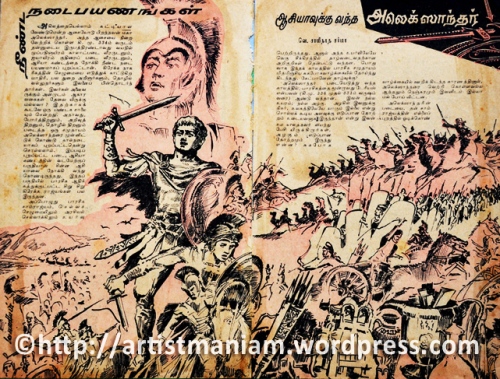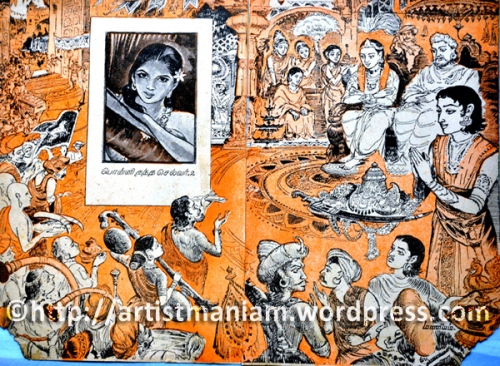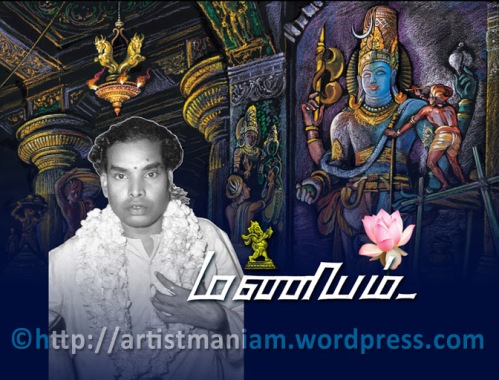Posted in Uncategorized | 1 Comment »
In the previous post, we had mentioned that we will look into other aspects of the painting. So, we begin this post with understanding certain unique compositional characteristics of artist Maniam’s paintings.

In the above illustration, there are two main elements which are strategically placed to give focus to the main theme of the scene – ‘The Royal Coronation’. The plate with the Royal crown, sword and garland looks as if it is flying without a base. And the size of the standing Rajaraja Cholan is much larger compared to other people in the courtroom.
If you use your hand to cover Rajarajan and the plate, the elements of foreground and the background look perfectly in proportion. But the introducing of these two elements which are slightly larger in scale, the artist breaks the perspective without disturbing the visual aesthetics. It is not new in traditional art that the object of greater importance in a painting to be bigger in scale than other objects. But delivering this in a beautiful way definitely requires good skill.
Analysing his works made me curious about who had inspired him to draw. It was his paternal uncle Lingayyah (who was only 4 or 5 years older to him). Uncle Lingayyah used to draw out of his own interest. It seems he would sit quietly on the thinnai (the front porch of a traditional South Indian home, which used to serve as a resting place for visitors) outside his home and draw people walking along Ponnambala Vadhiyar street in Mylapore. At that time, Sri S Rajam (Artist/musicologist) who was a very close friend of uncle Lingayyah, a neighbour Sri Vittal Rao and Sri Maniam used to watch him in action. That inspired all of them to pursue drawing as a hobby which later developed into their career. Only Sri Vittal Rao served in Reserve bank but still continued to paint all his life. He is now 86 yrs old and is one among a few we consult regarding artist Maniam’s childhood days.
Here is another illustration by Sri. Maniam on the subject of Alexander the Great. Let us look at how he composed the character of this image (late 1960s for Kalki Magazine).

Artist Maniam has skilfully brought out the main identities that Alexander the Great was known for. The first thing that comes to our mind about Alexander is his army, leadership quality, his valour and strength. If you look at the area where Alexander stands, there are actually four representations of him starting from the one on horse, one in action, one standing and one close up of the face with his soldier’s helmet. The way these figures are aligned gives the effect of how he rose to power and marked his identity.

The above illustration was made in early 1960’s (for Gangai magazine) for another historical novel. The manner in which the main character is portrayed and the way he has handled various elements in this riot scene is visually effective (take time to observe the illustration). We can actually hear the thunder, feel the strength of wind, the heat from the fire and emotion of every character in this composition.
Comparing all three illustrations, it is very clear that the size of the main character is dominant in all three compositions and the two colour painting process has been handled skilfully. Combining studies and techniques from western and Indian art to make the scene visually effective was indigenous to artist Maniam. Though he discontinued from The School of Arts during his second year, he never stopped learning. Every work that he had done was a result of a great deal of research and knowledge gained from various sources and we are now trying to understand those facets of his works.
In the next post, we will go in to the visual characterisation of various characters from Ponniyin Selvan.
Podcast of a radio interview of Sri Maniam Selven (about his life as an artist) conducted by Mr.Sri (Bay area, California) for his show on KZSU Stanford 90.1 fm on 9th February 2011 is available at www.itsdiff.com. Please follow the link to listen to the podcast.
Posted in Uncategorized | 12 Comments »
We are deeply humbled by the overwhelming response for the first post. This is only making us to work harder to keep up to your expectations. We appreciate your support and encouragement.
We initially thought of posting some biographical information about artist Maniam. But after looking at the comments, we have changed our mind to try and quench your thirst first.
Take a look at this picture.

No pictures from this blog may be reproduced, stored in a retrieval system, or transmitted
in any other form, or by any means, electronic, mechanical, photocopying, recording,
computer networking, or otherwise without prior permission
in writing from Mr. Maniam Selven.
This is a two colour illustration that was published in Kalki’s memorial issue after the great writer’s demise. That issue covered major accomplishments by Sri Kalki. The same was published in black and white earlier for the fifth volume of Ponniyin Selvan.
In this illustration, we can identify all the characters in their respective places as described by Sri Kalki. Artist Maniam has daringly attempted to play with perspectives and has very convincingly presented us with a complete finale scene of coronation of Sendan Amuthan .
Observing this composition, our eyes are drawn towards the main white figures. (We are purposefully restraining ourselves from identifying characters and would like the viewers to participate.) After that, our eyes start travelling from the lower right corner towards the top left corner. Details of the decoration outside the palace up until the palace gate, and the elephant going out after the royal procession is shown clearly. A complete scene that can be shown with a panning camera in a movie has been stilled in this composition.
Artist Maniam always chose to handle a very unique perspective for his works. He challenged himself by trying to bring the complete scene into visualisation and has definitely succeeded in giving a feeling of movement to the viewers. He did a lot of studies and researches to achieve this.
His practice of making use of anything or anybody as a subject for his drawing started even before he realised he would become an artist one day. My father recounted this interesting episode from what his grandfather (chinna thatha) had told him.
This happened sometime around 1934. Artist Maniam was studying in Vanniyar Sangam school in Nadu street, Mylapore, Madras. In those days, inspectors from the education department used to come on uninformed inspections to see if the classes were going on properly. It was during one such visit, the teacher of young Maniam’s class dozed off after a lesson and the students were happily chatting with each other. But our budding artist decided to sketch his teacher who was sleeping. The inspector having noticed this through the window, walked inside the class. Sudden silence made the teacher look up with a jerk and realising that the inspector was in, pretended as if he was asking the students whether they have finished the given work.
The inspector walked towards young Maniam and asked for that paper. Returning to the teacher, he showed the drawing and asked, ‘How long have you been sleeping for a student to draw like this?’ . This episode ended with young Maniam’s ears being twisted. I think this was the first reward he ever got for his drawing. 🙂
We welcome your feedback and comments about this illustration. We have left one more aspect of this illustration unexplained. We will discuss that in the next post.
Posted in Uncategorized | 15 Comments »

Artist Maniam… if he was alive, he would celebrate his 87th birthday today. People say that it doesn’t take a lifetime to leave a mark in history, but a moment that connects people together. Artist Maniam had that moment and sustained it for 18 years of his artistic life. Though he lived only till his 44th year, he continues to live on through his art which has become eternal.
When people recognize me as his grand daughter and when I see online forums discussing about his illustrations for Ponniyin selvan, I wonder how did he manage to reach so many people and leave such a profound mark, with his work that too within such a short span.
This made me read those novels and truly understand the relationship between the story and illustration. I realized that the marriage of these two is so crucial to make an impact on readers belonging to the present generation who are exposed to movies, internet and other faster paced Medias. And I think that stories like Ponniyin Selvan and Sivakamiyin Sabatham has made it to be able to live all these years and I am sure my grandchildren will enjoy it as much as I did. People are able to connect to the images of Pazhuvettarayar, Nandini or Naganandi that Maniam had created.
Being privileged to detailed descriptions of the key characters from Kalki, the artist in him gave form to Kalki’s descriptions. The understanding between the author and the artist was so great that I have heard many people say that Kalki’s writing complimented Maniam’s illustrations as much as his illustrations complemented the story.
With all these thoughts in my mind, I am starting to blog about him and his works today. I hope this blog will be a starting point and a window to all fans of Artist Maniam to view his works and know more about him. This blog is intended to share information about his life and works, analyse his masterful renditions in art and to discuss his studies and references.
I begin this blog on his birthday with the blessings of my grandmother Smt. Saraswathi Maniam, my parents and in-laws and all those who had the opportunity to know him personally. Special thanks to my husband who initiated this attempt, family & friends for their encouragement and Mr Vijay (www.poetryinstone.in) for sharing his inputs to make the blogging experience better.
Together, we welcome everyone to join us in this journey of discovery and understanding.
Posted in Uncategorized | 71 Comments »

